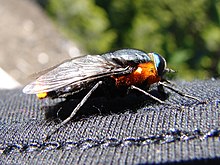| Osca lata | |
|---|---|

| |
| Scientific classification | |
| Domain: | Eukaryota |
| Kingdom: | Animalia |
| Phylum: | Arthropoda |
| Class: | Insecta |
| Order: | Diptera |
| Family: | Tabanidae |
| Subfamily: | Pangoniinae |
| Tribe: | Scionini |
| Genus: | Osca |
| Species: | O. lata
|
| Binomial name | |
| Osca lata (Guérin-Méneville, 1835)[1]
| |
| Synonyms | |
| |
Osca lata, the coliguacho or black horse fly, is a large horse fly whose range includes southern Chile and southern Argentina.[4][5][6] The fly has a striking reddish-orange coloration on the side of its thorax and abdomen. It is generally around 2 cm. in adult size.[7]
Like most species of horse flies, the females of Scaptia lata need to feed on mammalian blood before they can produce eggs.[8][9]
- ^ a b c Guérin-Méneville, F.E. 1829-1844, Insectes In his Iconographie du regne animal de G. Cuvier, ou representation d'apres nature de l'une des epeces les plus remarquables et souvent non encore figurees, de chaque genre d'animaux. Paris: J. B. Bailliere. pp. 576 pp., 104 pls.
- ^ Macquart, P.J.M. (1838). "Notice sur le genre Pangonie". Annales de la Société Entomologique de France. 6: 429–438, pl. 15. Retrieved 24 September 2022.
- ^ Enderlein, G. (1925). "Studien an blutsaugenden Insekten I. Grundlagen eines neuen Systems der Tabaniden". Mitteilungen aus dem Zoologische Museum. 11: 255–409.
- ^ González, Christian R.; Elgueta, Mario; KJrolow, Tiago Kütter; Henriques, Augusto Loureiro (2022). "Catalog of the horse-flies (Diptera: Tabanidae) of Chile". Zootaxa. 5091 (2): 201–257.
- ^ "Horse Fly from Patagonia". What's That Bug. 3 January 2009. Retrieved 17 February 2010.
- ^ "Tábano - Coliguacho (Colihuacho)". Pucón Chile. Archived from the original on 7 July 2011. Retrieved 17 February 2010.
- ^ Moucha, J. (1976). "Horse-flies (Diptera: Tabanidae) of the World. Synoptic Catalogue" (PDF). Acta Entomologica Musei Nationalis Pragae Supplements. 7: 1–320. Retrieved 11 September 2022.
- ^ González, C. R.; Sanhueza, Y. (2004). "Comparative study of mouthparts of the female of three species of Scaptia (Scaptia) Walker from Chile (Diptera: Tabanidae)". Acta Entomológica Chilena. 28 (1). Instituto de Entomología: 23–31. ISSN 0716-5072. OCLC 487184759.
- ^ Fairchild, G.B.; Burger, J.F. (1994). "A catalog of the Tabanidae (Diptera) of the Americas south of the United States". Memoirs of the American Entomological Institute. 55: vii + 249.